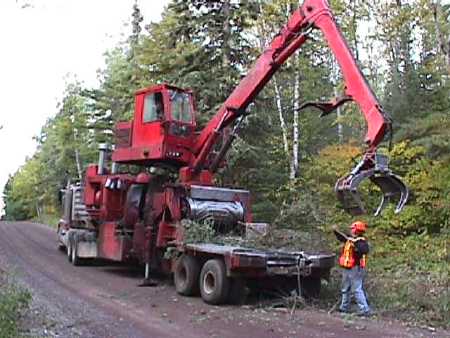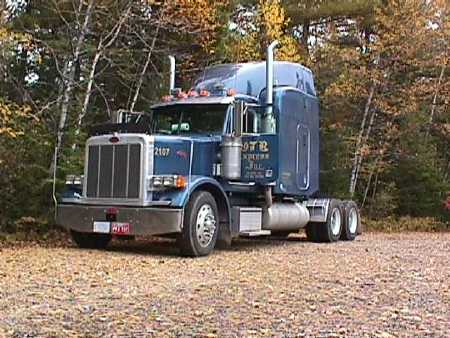10/31/99 – Halloween will be beautiful at Sawbill this year.
Clear skies and light breezes this morning bode well for the warm
temperatures forecast for this afternoon. This is likely to be
our last little hint of late summer before freeze up.
I attended the annual meeting of Northeastern
Minnesotans For Wilderness in Duluth yesterday. This is always
a fascinating event, with speakers that illuminate different facets
of the wilderness we all love.
This year, Lee Frelich, a researcher from the Department of
Forest Resources at the University of Minnesota, spoke about fire
ecology and large blowdown events. He said that fire history has
been accurately mapped within the wilderness back to the 1600’s.
Up to 100 years ago, each part of the wilderness would burn every
50 to 70 years. Most of these fires were low intensity ground
fires that burned out the understory, but left the fire resistant
pines unharmed. However, every 90 to 100 years, large canopy fires
would break out and burn huge areas of what is now the BWCA Wilderness
and the Superior National Forest. These more intense fires would
burn all the trees except for those along shorelines and exposed,
rocky outcrop areas. This explains why canoeists see so many large
white and red pines along the shorelines and ridgelines. The interior
areas were dominated by jackpine, unless two large fires passed
in less than a decade, in which case aspen and birch would thrive.
According to the Forest Service, under current conditions,
each part of the forest will burn every 2,000 years. This is due
to vigorous fire protection and climate change. The average temperature
in the BWCAW has risen 4 degrees in the last 100 years. Paradoxically,
this makes for a wetter climate, as it tends to draw Gulf of Mexico
moisture farther north, making thunderstorms more likely to carry
heavy rain when lightning is present. The warmer temperatures
also create more intense thunderstorms, resulting in a series
of large blow down events over the last few decades. Frelich said
the BWCAW blow down event of 1999 was not unique – it just garnered
more news coverage. He said that it is nearly inevitable that
the blown down area will burn in the next few years – probably
in a series a fairly large fires. If conditions are very dry when
the fires come, the forest will regenerate in a white cedar, birch,
aspen mix. If conditions are moderately dry, it will return to
the more typical jackpine type.
Chel Anderson, a former BWCA wilderness ranger and now a rare
plant ecologist with the Minnesota DNR, gave a slide show presentation
of the floral ecology of the BWCAW. She structured her talk by
habitat types, starting underwater and progressing through the
various habitats to the high, rocky hilltops. She introduced the
group to hundreds of plants, from common to rare, that are indigenous
to this region. She stressed that every species is intertwined
with, and dependent upon, many other species. In her calm and
thorough way, she brought home the wisdom of preserving large
landscapes for the overall health of all species – including the
human. I only wish I could remember even a quarter of the plants
she showed us. – Bill
10/29/99 – Some of you will recall the loon that became tangled
in fishing line on Alton Lake earlier this summer. David Chasson
brought the poor thing to us and we arranged transportation to
the wildlife vet clinic at the U of Minnesota in St Paul. The
loon had a badly broken beak. The lower beak was dangling straight
down.
We received this email from the vet clinic today:
Dear Bill,
So sorry it has taken so long to get back to you!! The loon that
came
in from you (and David Chasson I believe) had been tangled in
fishing
line according to our records. Our vet made the decision to euthanize
the bird-sorry. We sure wish it had been a better outcome. We
actually
had two loons in this year and neither of them made it. Thanks
for
helping out, though.
Connie Hart
Wildlife Coordinator
10/28/99 – Just like the red squirrels, we are scurrying to
put our lives in order for the coming winter. Our list seems to
grow even as we check off the top items. Drain water, pump septic
tanks, box up store stock, turn off the coolers and freezers,
stow the camping equipment, make lists of repairs needed in the
spring, order canoes, put Kevlar canoes inside, cover the firewood,
the list goes on and on. Soon it will include plowing snow, grooming
the ski trail and stoking the wood stove.
Ed Dallas, Poet Laureate of Sawbill, writes:
Good News!!! I just got word that I won 2nd place in The Fall
contest of
The League of Minnesota Poets for fixed form. It was a haiku:
wintry autumn mist
the chatter of a red squirrel
and smell of woodsmoke
10/23/99 – We’ve had a few emails asking for updates of family
and crew activities.
Last night Karl Hansen and Lee Stewart announced their intention
to be married this New Year’s Eve. The ceremony will be in the
Sawbill Campground on the exact spot where they first met in 1957.
Ruthie Hansen is home for the weekend from the Minnesota High
School for the Arts. She is enjoying her second, and final, year
there. She is in the Literary Arts program and is immersed in
researching college options.
Adam Hansen is a freshman at the U of Wisconsin, Madison. He
is training with the cross country ski club and reporting for
the Badger Herald. The Sawbill Frisbee Golf Association is inactive
for the time being.
John (OB) Oberholtzer is currently touring in Ireland with
his friend Kathleen Heikes. Kathleen’s mother won the all expenses
paid trip for two and gave it to OB and Kathleen. We got email
from them yesterday and it sounds like they are having a wonderful
experience.
Here is a run down of the crew and where they are right now:
Josh Bacskai is studying at U of Wisc., Milwaukee; Anna Constance
is a sophomore at Macalester College in St Paul; Dave Freeman is
still here, but will be moving to Ely to lead winter camping trips
by dog sled for Wintergreen Lodge this winter; Eric Frost is in
his senior year at the U of Ohio in Athens; Erik Hoekstra is in
his senior year at U of Wisc, Madison. He is the publisher of
the Badger Herald this year; Crescent Lake campground hosts Jo
and Bill Koski are nearby at their home in Two Harbors; Sawbill
Lake campground hosts Jim and Fran Sampson are back at their winter
home in Florida; Laura Smith is in her sophomore year at Macalester
College in St Paul; Laura and Nathan TerBeest are both at Northwestern
College in Iowa. Laura is a junior and Nathan a freshman. Nathan
is on the football team which is ranked 13th nationally; Sawbill
Lake campground hosts Jim and Rachel TerBeest are both back at
their jobs with the Omaha public schools; Natasha Warner is helping
her parents winterize their house in Macgregor, MN. She plans
to move back to Grand Marais in January.
Heavy winds over the last day and a half have brought down
some of the trees weakened by the July 4th mega-storm. More than
40 trees were down on the back road to Grand Marais yesterday.
A large red pine blocked the campground road near campsite #18
this morning. The RVing club from International Falls, MN is camped
in the Sawbill Campground this weekend.
Jim Romito sent along the following haiku:
autumn snowflakes fall
in the wilderness that we
will drink next summer
– Bill
10/22/99 – It snowed this morning. I stood in front of the
big picture window in the living room in my pajamas and watched
the big heavy flakes fall diagonally down. Clare shuffled into
the room in her slippers. "It’s snowing!" I exclaimed.
"Yeah, it’s been snowing all week." she responded. "Oh."
I shrugged, content to watch what was my very own first snow-fall
of the year.
The Hansen family selected Halloween pumpkins in Duluth yesterday.
We’re keeping them inside for now so they don’t freeze before
we carve them.
There are no cars in the parking lot, but Minnesota schools’
MEA vacation has prompted a few courageous families to drive up
for one last canoe trip before the ice sets in. -Ruthie 🙂
10/18/99 – For the second time this year, we woke up to a snow
covered forest. This time of year, the snow creates strong contrast
against the dark, shining woods. It is a black and white snap
shot. Only two cars in the parking lot. – Bill
10/16/99 – This October Saturday has produced a heavy rush
of customers. At one point we actually had two groups in the store
at the same time 😉
The leaves are all down now, which opens the view into the
woods dramatically. A hidden landscape emerges allowing you to
see the shapes and contours of the earth. The bare, glistening
tree trunks provide a vertical counterpoint to the undulating
earth forms. Large boulders, whimsically named "erratics,"
emerge from their leafy camouflage to punctuate the sylvan sentences.
I always watch them carefully in case they decide to do something
erratic.
Jim Cordes is writing a book on the July 4th Storm that hit
the Boundary Waters with such impact. He is looking for personal
stories from the people who experienced the storm first hand.
Jim’s not on-line, so contact him at:
Jim Cordes
Box 135
Lutsen, MN 55612
10/14/99 – In classic October fashion, the weather progressed
from beautiful, sunny and mild – to gray, windy and sleeting in
about 12 hours. There is only one car on the parking lot now.
Some brave souls now have the wilderness essentially to themselves.
I have a fantasy about canoeing out some year, getting frozen
in, stashing the canoe and snowshoeing out. In the spring, I would
repeat the process, hiking out on the late spring ice and waiting
for the lakes to thaw. It is a lovely, mysterious time of year
and completely wild.
Yesterday, twenty three students from Kelly High School in
silver Bay came up for a three hour canoe trip. Silver Bay is
about thirty miles toward Duluth from Tofte. North Shore visitors
will remember it by the huge iron ore processing plant located
there. The students were on a monthly field trip that takes them
out of the school for various practical learning experiences in
the community. Predictably, most of the kids had never been to
the BWCA Wilderness or in a canoe. Their teacher told me that
we had "created some converts." – Bill
10/9/99 – While running yesterday, I saw a common but rarely
encountered animal. A beautiful Blue Spotted Salamander was making
its way across the Sawbill Trail. A herpetologist once told me
that salamanders are extremely common on the Superior National
Forest. He said that they represent the largest mass of vertebrate
life in the forest. In other words, there are more total pounds
of salamanders than there are of moose, bear of even mice. The
salamanders live in the litter on the forest floor and are almost
never seen on the surface, except when they migrate in the spring.
What the little fellow I saw was up to, I have no idea. I did
gently pick him up and transport him to the far side of the road,
to reduce his chance of becoming a grease spot.
10/6/99 – Yikes, the BWCA Wilderness has been named by National
Geographic Traveler magazine as one of the "50
greatest places of a lifetime, destinations they believe no
curious traveler should miss."
Given the status of this magazine, this is pleasing and somewhat
frightening at the same time. Luckily, it came at the right time
of year, so we won’t be overwhelmed with a sudden wave of new
visitors.
Ed Dallas, the Poet Laureate of Sawbill, has been on a roll
lately:
in the tree branches
replacing each falling leaf
a view of the lake
10/4/99 – We received the following email from Steve and Cynthia
Crooks who ended their canoe trip yesterday morning:
Thanks very much for thawing out the pipes this morning – it
was so good
to have that post-trip shower! My wife commented that this was
the
first time she had taken a shower in a bathroom where she could
see her
breath. Quite refreshing.
We woke up Saturday morning to snow blowing at a 45-60 degree
angle over
Flame lake, had our tea and oatmeal and broke camp. On Burnt Lake
we
were tempted by the blue sky and calm water to make the portage
to Kelly
for a little exploring, but my wife’s knee was sore from a slip
at the
portage. We opted for Smoke Lake, where we were met with ice particles
in the eyes. Part way across the Lake we could look left and see
blue
sky, look right and see an ice storm! Our campsite on Smoke was
a good
stop – during the night we were out gazing at the stars – too
cold to
lie back for long, though. The knee was definitely stiffer in
the
morning so we were glad to be closer to "home." Thanks
again for the
showers.
Steve & Cynthia Crooks
Sawbill’s Poet Laureate, Ed Dallas, sent this along:
tracing the canoe route
on the map my finger stops –
again the wolves howl
10/1/99 – There are many trucks at Sawbill today. This huge
chipper truck has been working along the Sawbill Trail clearing
trees that fell into the right of way during the July 4th storm.
It can grind up a full sized tree in under ten seconds.

Bill and Doug Alexander arrived in style for their canoe trip
today. Doug is and over the road trucker. Bill flew from his home
in North Carolina to Minneapolis where Doug met him in his Peterbilt.
It is certainly the highest powered camper we’ve ever had at Sawbill.

Here is a haiku from Ed Dallas, the Poet Laureate of Sawbill.
at bog’s edge maples
flame red out in the brown grass
tamarack still green
